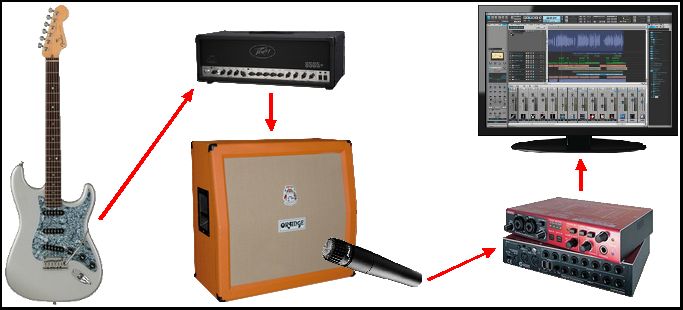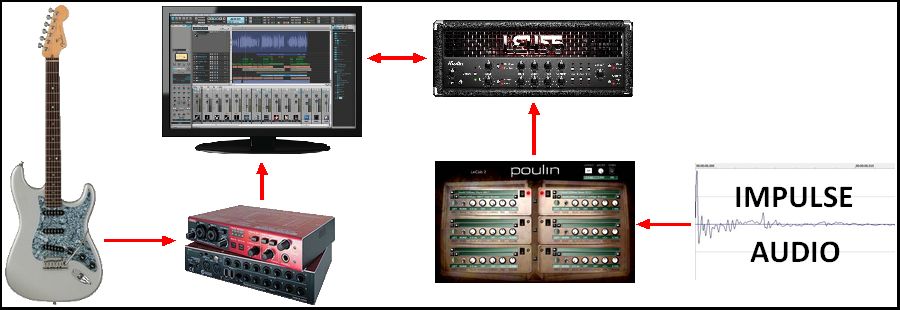

? | Home page | Simulators



This is an essential step. As we are doing Rock music, we are necessarily going to use guitars. And it'd better sound good and heavy and impressive. If guitare comes second, it's not Rock anymore, so you must take very good care of it. But in a home studio, it is not easy to have access to good hardware that will take our guitar sounds to the next level. Real guitar amps are expensive, take space and are very noisy but fortunately, virtual amps have made enormous progress and anyone can now get gear simulations of all kinds.
Amp simulators attempt to reproduce the sound of real guitar and bass amps. Some will recreate one precise model, some will offer access to different models and brands. You can easily find reproductions of the most famous brands from one simulator to the next, but their quality and fidelity to the original can vary much from one sim to the other. You can find both free and retail simulators.
Amp sims of course are only necessary if you don't use a real guitar amp. A good amp sim will allow you to play and record with very limited noise and give excellent results. Frankly, it becomes very difficult to distinguish between a good amp sim and a real amp. Simulators have a bit less dynamics, grain and warmth, but within a good mix, the difference is subtle and if you set the right parameters, most people won't hear any difference. Another advantage in favor of simulators: it doesn't take any physical space and you can have many different models at your disposal without spending a fortune. On the other hand, when it comes to live play, nothing is worth a good old guitar amplifier... But here, we're talking about recording in a home studio.
Caution: I put forward amplifier head simulators, to which you need to add speaker cabinet simulators to build up a complete guitar amplifier. As you can hear, it sounds rather aggressive without a cabinet. According to the cabinet, the microphone and its positionning, you can get very different sounds. It's up to you to find the desired setting. Don't hesitate to use several cabs and several mikes for a single guitar as it allows for a fuller sound.
NB: all the plugins presented here are for PC with Windows. If a Mac version exists, I'll mention it and give you the download link from the official website.






As each D.A.W. is different, I cannot give you the exact procedure but only a general method. Caution: as a Windows PC user, the files I present are for Windows, and so are the explanations below.
1 - Download the plugin file you are interested in.
2 - Unzip the plugin and copy the files it contains in the VST folder of your D.A.W.. I advise you to create a folder for each plugin.
For instance, if you download the TSE X50 zip file, copy its content within the folder "C:\...\VST\TSE - X50".
In order to sort things better, I usually create this type of sub-folders "C:\...\VST\Amp simulators\TSE Plugins\X50", so everything is sorted by type of plugins and by brand.
3 - If your D.A.W. doesn't automatically do it when starting, use its plugin search/analyse function. You may have to close and restart your D.A.W. to recognize the newly installed plugins. Check in the D.A.W.'s options that it knows where to look for. It is usually possible to set one or several paths that will target the folder(s) containing your plugins.
4 - Once the new plugin is recognized by your D.A.W., place it on the track or the bus you want. Some plugins only work if they are placed on stereo tracks or buses.
5 - Place an amplifier simulator first.
6 - Then, place a cabinet simulator, also known as an impulse loader, like LeCab 2 from Poulin, or NadIR, for example.
7 - In the cab simulator, load the impulse of your choice. Impulses, whether they are free or commercial ones, are small-sized wav audio files that you will place wherever you want on your hard drive. They don't need to be located in your VST folder. So load the impulse of your choice, for example a Marshall cabinet impulse.
8 - If everything goes well, you now have an amplifier simulator and a cabinet simulator, very much like a real amplifier.
9 - Click on the "monitoring" button of your guitar track, the very one that allows you to hear yourself playing. You can now enjoy the sound of your virtual guitar/bass amplifier.
10 - Change the settings in the amp simulator windows, set the volume, the bass, mid and trebble, etc. Change the settings as well in the cab simulator if needed (high and low pass, panning...)
11 - Pay attention to the latency. Set it low enough so that there is no delay between the moment you play your guitar and the moment you hear the sound coming out of your headset or monitors. Latency only needs to be very low when you play or record (in order to avoid a sound delay). Once the recording is over, when it is time for mixing, you can raise the latency again, in order to get more processing power. The lower the latency, the more the computer processor will be in use. That can be problematic with big musical projects, if your computer is not powerful enough to process things in real time.

Messages page # 1 2 3 4 5 6 7 8 9 10 11 12 13 14 15 16 17 18 19 20 21 22 23 24 25 26 27 28 29 30 31 32 33 34 35

Moss
le 29/11/2014 à 09h04
Bravo, c'est clair et intelligent, sans les lieux communs habituels. Mais petite erreur sur la compression, ayant beaucoup travaillé sur le sujet : l'attack et le release commencent dès que le signal franchit le seuil, dans un sens ou dans l'autre. Il n'y a pas de temporisation mais un fade-in pour l'attaque et un fade-out pour le release, plus ou moins lents selon le réglage.

Neyutakim
le 21/10/2014 à 01h36
Super mon gars, et surtout un grand merci pour tout ce que tu fais !!! C`est vraiment cool !!! Vraiment !! Continue comme ça !!! merci.

SoloDuck
le 16/08/2014 à 14h11
Salut Grebz,
Nickel tes tutos, très très utile. Je suis assez fan des simu de LePou, juste un détail qui me chagrine, tu fournis les presets de tes démos .fxp, mais comment les charger dans les simu ? Je me ramasse une erreur "Metal - HyBrit.fxp This file is not a preset or bank for Poulin_HyBrit_Head_v1_1a." Y aurait-il des versions différentes ? A+ m/
* * * * * * * * * * * * * * * *
<em>Bonjour,
Après vérification, les presets fxp fonctionnent bien chez moi dans Sonar et dans Reaper, mais je ne dispose pas d'autres séquenceurs pour vérifier. Je suis en train de réaliser des captures d'écran de chacun des presets, afin que vous puissiez reproduire les réglages, même sans le fichier de preset.
Vous pouvez accéder aux captures d'écran avec un lien que j'ajoute en-dessous de chaque preset téléchargeable.
Grebz</em>

zimblot
le 08/07/2014 à 17h34
Bonjour,
En préambule, je tiens à vous féliciter pour votre site et l'altruïsme dont vous faites preuve. Merci. Ma question : J'ai téléchargé sur votre site, 5ORCERY. J'aimerais savoir (si c'est possible) à quels styles de morceaux correspondent chacun des presets de ce plugin. N'étant pas "un chat" dans la MAO, je les utilise à l'intuition et quand même un peu à l'écoute, mais c'est vraiment empirique. Si vous pouviez me guider je vous en serais très reconnaissant.
Merci d'avance.
Cordialement.

Jazzhands
le 07/06/2014 à 21h37
Another free DAW to add is <a href="http://lmms.sourceforge.net/home.php" target="_blank">LMMS</a>. I use the Windows version.
Traduction :
Autre séquenceur gratuit, <a href="http://lmms.sourceforge.net/home.php" target="_blank">LMMS</a>. J'utilise la version Windows.
* * * * * * * * * * * * * * * * * * * *
<em>Thanks for the tip, but LMMS doesn't allow for audio recording. You can process audio that you import into it (audio recorded through another recording software of your choice, or any audio files you have at your disposal), but it's too big a limitation for me to consider presenting it.
It is a major drawback in my opinion, for all the people who want to record vocals or instruments through a microphone, or by plugging it directly.
Of course, for anyone who only wants to use virtual instruments or existing audio files, LMMS will be an option. And it's free, as you mentioned.
Among great free software that compete with commercial software, you have GIMP (vs Photoshop), Blender (vs 3D Studio and Maya), Open Office and Libre Office (vs Microsoft Office), but I'm still waiting for a complete free D.A.W. that could rival with Sonar, Cubase or ProTools and such...
Reaper is what comes closest to that dream as it can be used for free without limitations, but it's not a freeware and you are supposed to pay for it if you use it.
Traduction :
Merci du tuyau, mais LMMS ne permet pas d'enregistrer de l'audio. On peut traiter de l'audio que l'on importe (enregistré avec un autre logiciel d'enregistrement de son choix, ou tout fichier audio à disposition), mais c'est une limitation trop important pour que j'envisage d'en faire une présentation.
C'est un inconvénient rédhibitoire à mes yeux pour tous ceux qui souhaitent enregistrer des voix ou des instruments via un micro ou en branchement direct.
Bien sûr, pour ceux qui se contentent d'utiliser des instruments virtuels ou des fichiers audio existants, LMMS est un choix possible. Et gratuit, comme vous l'avez dit.
Parmi les excellents logiciels gratuits susceptibles de rivaliser avec des logiciels payants, il y a GIMP (vs Photoshop), Blender (vs 3D Studio et Maya), Open Office et Libre Office (vs Microsoft Office), mais j'attends toujours l'arrivée d'un séquenceur gratuit capable de rivaliser avec Sonar, Cubase, ProTools et leurs équivalents...
Reaper est ce qui s'approche le plus de ce rêve puisqu'il est utilisable gratuitement sans limitations, mais ce n'est pas un logiciel gratuit pour autant et vous êtes censé le payer si vous vous en servez.
Grebz</em>
